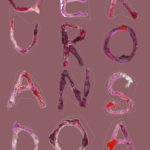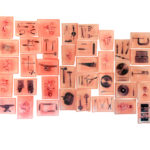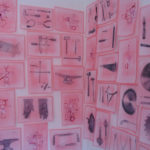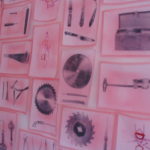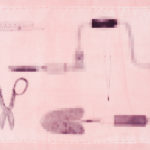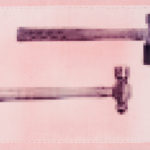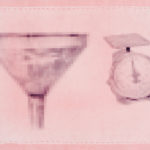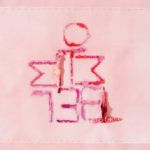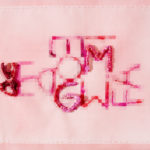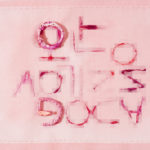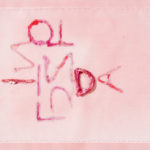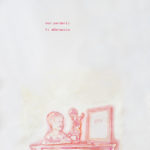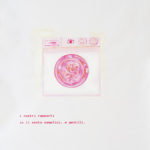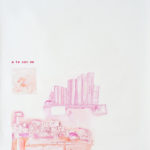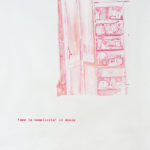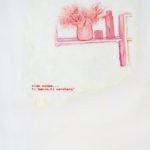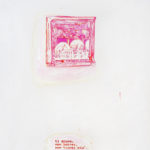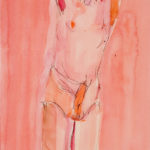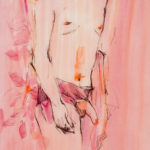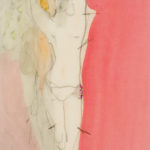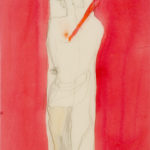
Quaderno rosa 2004
- wp_7961204
- 0
- on Apr 13, 2017
Quaderno rosa
“The Waves grew sleepy Breath did not The Winds like Children lulled Then Sunrise kissed my Chrysalis And I stood up and lived”
E.D.
Marina Gasparini’s work is a notebook where all literary and artistic activities are woven together. We’re not talking only about poetry or analogies, but of the concrete technique adopted by the artist to make visible this magical meeting of words and images.
In the work of Marina Gasparini we can trace the artist’s deep insight into her own language, and at the same time a will, a necessity to break any conscious boundary; a great formal severity together with a deep sense of loss and abandonment; a cold and almost photographic eye and the warmth of the brush strokes.
And all of this in a “simple”, unforced cohabitation, because what matters for the artist is the net of connections between objects and words, expression and meaning, between one’s own interior landscape and the world outside. Between what’s left to us and what is escaping from us all the time.
A Doric capital bearing the engraved words Plus Ultra welcomes us in the first hall, dedicated to the sea. The Pillars of Hercules in the Strait of Gibraltar, where that warning was placed – advising never togo beyond that point – were the last reachable spot of land for the mariners. The pillars marked in such a way the end of the world. Beyond that the unknown, or simply nothingess, awaited.
Disarranged chaotically among the pen blue background, fragments of objects tell us of a day spent at the beach, collecting what the sea brings to shore. Are those objects inclined to disappear, or theyd rather go back to the waves? Do they want to be recognized, or they would prefer to be polished beyond recognition? What does for Marina Gasparini mean the retrieval of this floating flotsam and jetsam? Is it a question of knowledge andcertainty being those small fragments of existence stolen from the implacabile time flux? Or are those simply objects which reflect the emotions the artist’s gaze has put in them?
As always very attentive towards the structure of the composition, the artist has conceived the first hall as a sort of threshold, a frontier that can be crossed only by those who dare to “leap” into the world of the unexpected and unexplicable.
The second hall is all pink, a ‘‘Confetti Pink” with some darker tones that fade progressively into white. Here various household objects are represented:furnishings, shelves, electrical appliances, things that inspire in us a sensation of routine, of homely calm.
If not for the intervention of the words, which cause a leap in perceptions, all of this would just dissolve in a glorious retrieval of fragments of real life, at first simply photographed and then “serenely” painted in pink colours.
Like the proustian madeleine – which, dipped in the tea cup, induces at first a happy, almost ecstatic state of mind, but
after that provokes a surge of philosophical self-questioning – so is the art Marina Gasparini. At first we taste asensation of rosy happiness, but then, when we try to grasp its meaning, something puts us in a state of anxiety. That “something” are in fact the words, thanks to whom the artist introduces between us and the images a narration, develops a story :
-…fame la semplicita il disio-,- i nostri rapporti io li sento semplici, e gentili-, -ciao scema…ti bacio, ti cerchero-, -non perderti ti abbraccio-, -ti giuro, non potrei, non vivrei piu, – a te con me-.
Are these just fragments of an amorous dialogue? Or verses of a poem? Or asong’s lines? Or e-mail messages? Whatever they are, they instigate in us a desire to know, to understand, to undo the mystery which binds those words to those objects. Thirsty for knowledge, captured by the schemes of logic, we often forget that in all of use there’s an internal timeless soulscape, in which things, images and words simply show their emotional value. Thanks to these emotions, feelings and sensations, every experienced moment in one’s life is something unique and unrepeatable.
The effort of Marina Gasparini is to join in a sweet embrace real life experiences and the dreams of other things that might come to be, thus casting the resulting feeling of desire in an extratemporal area. Thanks to this embrace, made of mysterious harmonies, we are allowed to proceed plus ultra, in that “dark country” which is the human soul. Maybe, as Proust suggested, the time has come for us to put aside the cup of tea and look inward.
Maura Pozzati
Le onde s’assopirono – non cosi il mio respiro- Come bambini i venti intonarono canti di culla – II Sole che sorgeva baciò la mia Crisaiide Ed io mi alzai – per vivere- Emily Dickinson
II lavoro di Marina Gasparini è come un quaderno in cui attivita letteraria e artistica si intrecciano indissolubilmente tra loro.
Non si tratta solo di analogie e poetiche, ma di una concreta tecnica che I’artista utilizza per rendere visibile questo magico incontro di immagini e parole. Nelle opere di Marina Gasparini è rintracciabile una vera e propria coscienza del linguaggio, accanto a una voluta necessità di infrangerne le regole, un grande rigore formale insieme al senso della perdita e dell’abbandono. la freddezza dell’occhio fotografico accanto al calore del pennello. E tutto convive “semplicemente”, senza forzature, poichè ciò che importa all’artista e la rete di relazioni tra gli oggetti e le parole, tra il significante e il significato, tra la propria interiorità e il mondo esterno, tra ciò che rimane e quello che fugge via.
Un capitello dorico con incise le parole Plus ultra ci accoglie nella prima sala, dedicata al mare. Le colonne di Ercole nello stretto di Gibilterra, dove era inciso quell’ avvertimento a non procedere oltre, erano (’ultimo punto raggiungibile per i naviganti. Le colonne marcavano cosi la fine del mondo. Oltre I’ignoto, il nulla. Squadernati e scompaginati tra I’azzurro pennarello dello sfondo frammenti di oggetti stanno a raccontare una giornata passata sulla spiaggia, a raccogliere ciò che proviene dal mare. Quegli oggetti vogliono resistere alla sparizione o preferiscono tornare tra i flutti? Intendono farsi riconoscere o essere levigati fino a perdere la loro identità? II recupero di quei piccoli relitti è per Marina Gasparini uno strumento di conoscenza e di certezza, essendo piccoli frammenti rubati all’inesorabile fluire del tempo? Oppure sono oggetti che ci restituiscono le valenze affettive che lo sguardo dell’artista ha depositato su essi? Come sempre attenta all’architettura della composizione, I’artista ha allestito la prima sala come una soglia, una frontiera che può attraversare solo chi ha la voglia di fare un “salto” nell’imprevedibile e nell’inesplicabile.
La seconda sala e tutta rosa, un rosa confetto con sfumature più scure, che dileguano a poco a poco nel bianco.
Sono rappresentati oggetti vari, suppellettili, mensole, elettrodomestici che ci fanno respirare una sensazione domestica, di calma quotidiana. Se non fosse per I’intervento delle parole, che producono un piccolo salto percettivo, tutto si dissolverebbe in un gioioso recupero di frammenti di vita vissuta, prima fotografati e poi dipinti “serenamente” in rosa. Ma come la madeleine di proustiana memoria, che inzuppata nel the una prima volta fa scattare uno stato di felicità e quasi di estasi, ma che alla seconda sorsata provoca delle domande filosofiche sul significato di ogni sensazione, cosi Marina Gasparini ci pone nella stessa condizione.
Gustiamo alia prima una sensazione di rosata felicita, ma lla seconda, quando cerchiamo di comprendere il significato, qualcosa ci induce in uno stato di turbamento. Quel qualcosa sono proprio le parole, quando I’artista introduce tra noi e le immagini una narrazione, sviluppando una storia.
…fame la semplicità il disio-, i nostri rapporti io li sento semplici, e gentili-, ciao scema…ti bacio, ti cercherd-,non perderti ti abbraccio-, ti giuro, non potrei, non vivrei piu-, a te con me-.
Sono frammenti di un dialogo amoroso? Sono versi di una poesia? Sono strofe di una canzone? Sono messaggi di posta elettronica? Qualunque cosa siano, fanno nascere in noi un desiderio di sapere, di capire, di sciogliere il mistero che lega quelle parole a quegli oggetti. Assetati di conoscenza, presi dagli schematismi della logica, dimentichiamo spesso che esiste un tempo dell’anima, in cui le cose, le immagini e le parole manifestano semplicemente il loro valore affettivo. Sono emozioni, sentimenti, sensazioni che fanno di un attimo vissuto qualcosa di unico e irripetibile. Lo sforzo che compie Marina Gasparini per noi, e quello di unire in un dolce abbraccio il veramente vissuto con il sogno di viverlo, proiettando il desiderio che ne viene in una zona extratemporale. E grazie a questo abbraccio, fatto di misteriose corrispondenze, ci e consentito procedere plus ultra, in quel “paese tenebroso” che e I’animo umano. Forse, come diceva Proust, e il momento di deporre la tazza e rivolgersi al proprio animo.
Maura Pozzati
